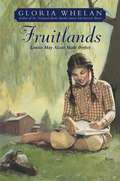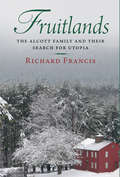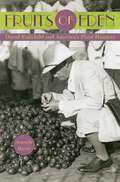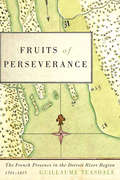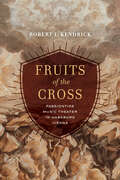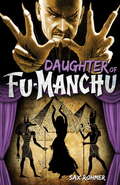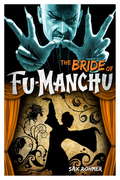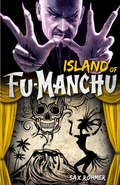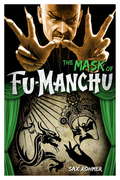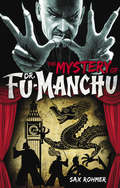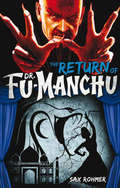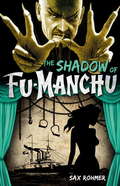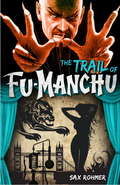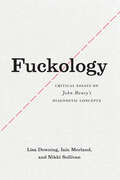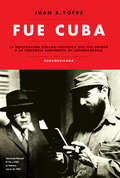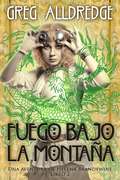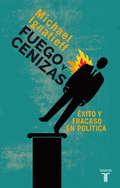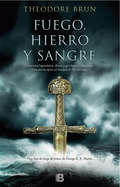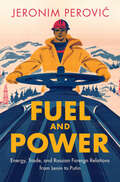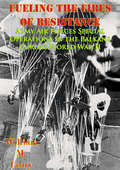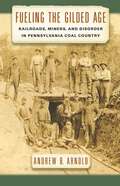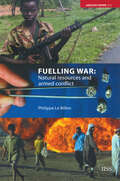- Table View
- List View
Fruitlands
by Gloria WhelanWe are all going to be made perfect . . . In 1843, with all their possessions loaded onto a single wagon, ten-year-old Louisa May Alcott and her family bravely set out into the wilderness to make a new home for themselves on a farm called Fruitlands. Louisa's father has a dream of living a perfect, simple life. It won't be easy, but the family has vowed to uphold his high ideals. In her diary -- one she shares with her parents -- Louisa records her efforts to become the girl her parents would like her to be. But in another, secret diary, she reveals the hardships of this new life, and pours out her real hopes and worries. Can Louisa live up to her father's expectations? Or will trying to be perfect tear the family apart?
Fruitlands: The Alcott Family and Their Search for Utopia
by Richard FrancisThis is the first definitive account of Fruitlands, one of history's most unsuccessful--but most significant--utopian experiments. It was established in Massachusetts in 1843 by Bronson Alcott (whose ten-year-old daughter Louisa May, future author of Little Women,was among the members) and an Englishman called Charles Lane, under the watchful gaze of Emerson, Thoreau, and other New England intellectuals. Alcott and Lane developed their own version of the doctrine known as Transcendentalism, hoping to transform society and redeem the environment through a strict regime of veganism and celibacy. But physical suffering and emotional conflict--particularly between Lane and Alcott's wife, Abigail--made the community unsustainable. Drawing on the letters and diaries of those involved, Richard Francis explores the relationship between the complex philosophical beliefs held by Alcott, Lane, and their fellow idealists and their day-to-day lives. The result is a vivid and often very funny narrative of their travails, demonstrating the dilemmas and conflicts inherent to any utopian experiment and shedding light on a fascinating period of American history.
Fruits of Eden: David Fairchild and America's Plant Hunters
by Amanda HarrisAt the turn of the nineteenth century—when most food in America was bland and brown and few people appreciated the economic potential of then-exotic foods—David Fairchild convinced the U.S. Department of Agriculture to finance overseas explorations to find and bring back foreign cultivars. Fairchild traveled to remote corners of the globe, searching for fruits, vegetables, and grains that could find a new home in American fields and in the American diet.In Fruits of Eden, Amanda Harris vividly recounts the exploits of Fairchild and his small band of adventurers and botanists as they traversed distant lands—Algeria, Baghdad, Cape Town, Hong Kong, Java, and Zanzibar—to return with new and exciting flavors. Their expeditions led to a renaissance not only at the dinner table but also in horticulture, providing diversity of crops for farmers across the country.Not everyone was supportive, however. The scientific community was concerned with invasive species, and World War I fanned the flames of xenophobia in Washington. Adversaries who believed Fairchild’s discoveries would contaminate the purity of native crops eventually shut down his program, but his legacy lives on in today’s modern kitchen, where navel oranges, Meyer lemons, honeydew melons, soybeans, and durum wheat are now standard.
Fruits of Perseverance: The French Presence in the Detroit River Region, 1701-1815 (McGill-Queen's French Atlantic Worlds Series #4)
by Guillaume TeasdaleFounded by French military entrepreneur Antoine Laumet de Lamothe Cadillac in 1701, colonial Detroit was occupied by thousands of French settlers who established deep roots on both sides of the river. The city's unmistakable French past, however, has been long neglected in the historiography of New France and French North America. Exploring the French colonial presence in Detroit, from its establishment to its dissolution in the early nineteenth century, Fruits of Perseverance explains how a society similar to the rural settlements of the Saint Lawrence valley developed in an isolated place and how it survived well beyond the fall of New France. As Guillaume Teasdale describes, between the 1730s and 1750s, French authorities played a significant role in promoting land occupation along the Detroit River by encouraging settlers to plant orchards and build farms and windmills. After New France's defeat in 1763, these settlers found themselves living under the British flag in an Aboriginal world shortly before the newly independent United States began its expansion west. Fruits of Perseverance offers a window into the development of a French community in the borderlands of New France, whose heritage is still celebrated today by tens of thousands of residents of southwest Ontario and southeast Michigan.
Fruits of the Cross: Passiontide Music Theater in Habsburg Vienna
by Robert L. KendrickIn this first detailed study of seventeenth-century sepolcri—sacred operas written for court performance on Holy Thursday and Good Friday—Robert L. Kendrick delves into the political and artistic world of Habsburg Vienna, in which music and ritual combined on the stage to produce a thoroughly original art form based on devotion to Christ’s Tomb. Through the use of allegorical characters, the musical dramas ranged from the devotionally intense, to the theologically complex, to the ugly anti-Jewish, but played a unique role in making Passion piety relevant to wider cultural concerns. Fruits of the Cross suggests that understanding the sepolcri has implications for the theatricalization of devotion, the power of allegory, the role of queenship in court ideology, the interplay between visuality and music, and not least the intellectual centrality of music theater to court self-understanding.
Fu-Manchu: Daughter of Fu-Manchu
by Sax RohmerAcross the sands of Egypt, Nayland Smith pursues Fah Lo Suee, the deadly daughter of Fu-Manchu. Possessed of all her father's subversive secrets and driven by his unquenchable thirst for power, she has pillaged the tomb of the Black Ape for the key to its ancient mysteries - and therefore leadership over all the evil cults of the East. No one can stop her - except perhaps Fu-Manchu himself!A brand-new edition of the classic novel.
Fu-Manchu: The Bride of Fu-Manchu
by Sax RohmerA strange epidemic sweeps the French Riviera - a biological weapon created by Dr. Fu-Manchu. Dr. Petrie is called upon by the French authorities, and when the truth emerges, Denis Nayland-Smith is summoned to help stop his arch-foe before he can succeed in spreading his plague across Europe. As they struggle to contain the horror, Petrie's friend, the botanist Alan Sterling cannot stop thinking of the mysterious Fleurette, unaware that the beautiful girl he chanced upon was raised by the emperor of evil himself, Dr. Fu-Manchu. One of the finest novels in the series, its biological theme is a precursor to Ian Fleming's On Her Majesty's Secret Service, and Fu-Manchu himself is the prototypical Dr. No.
Fu-Manchu: The Island of Fu-Manchu
by Sax RohmerThe year is 1941, and the world is engulfed in war. Having consolidated his forces, Fu-Manchu seeks to tip the balance of power by launching assaults from a hidden stronghold in the Caribbean. His target: the United States naval forces, just entering the global conflict. To stop the Devil Doctor, Sir Denis Nayland Smith and his ally, Bart Kerrigan, pick up the trail in London during the blackout, following it to New York, then the Panama Canal, and finally the land of voodoo--Haiti. There they face the enemy's deadly combination of advanced technology and deep-rooted mysticism!ALSO IN THIS VOLUMEA LONG-LOST NAYLAND SMITH SHORT STORY!AFTERWORD BY LESLIE S. KLINGER
Fu-Manchu: The Mask of Fu-Manchu
by Sax RohmerAfter discovering the tomb of El Mokanna - the Veiled Prophet - and retrieving the precious relics buried there, the eminent archaeologist Sir Lionel Barton blows up the tomb. The heretic sect faithful to Mokanna interpret the fireball as their prophet's second coming, and a violent uprising begins. Meanwhile, the insidious Dr. Fu-Manchu senses an opportunity to use the powerful relics for his own evil ends. The action stretches from Persia to Cairo, then back to London, including an extraordinary confrontation inside of the Great Pyramid. Along the way his opponents face Ogboni killers, mind-control drugs, dervishes, and a "ghost mosque."
Fu-Manchu: The Mystery of Dr. Fu-Manchu
by Sax RohmerLondon, 1913--the era of Sherlock Holmes, Dracula, and the Invisible Man. A time of shadows, secret societies, and dens filled with opium addicts. Into this world comes the most fantastic emissary of evil society has ever known... Dr. Fu-Manchu.Denis Nayland Smith pursues his quarry across continents and through the back alleys of London. As victim after victim disappears at the hands of the Devil Doctor, Smith must unravel his murderous plot before it is too late. Includes a special feature by Leslie S. Kilnger
Fu-Manchu: The Return of Dr. Fu-Manchu
by Sax RohmerLondon, 1913--the era of Sherlock Holmes, Dracula, and the Invisible Man. A time of shadows, secret societies, and dens filled with opium addicts. Into this world comes the most fantastic emissary of evil society has ever known... Dr. Fu-Manchu.The insidious doctor returns to Great Britain with his league of assassins, the dreaded Si-Fan. He seeks to subvert the realm at the highest levels, but Fu-Manchu has his own secrets--which he will protect by any means.
Fu-Manchu: The Shadow of Fu-Manchu
by Sax RohmerWorld War II has ended. The United States is locked in a Cold War with the Eastern Bloc. It's the time of mutually assured destruction, yet the atomic bomb isn't the only weapon to fear. And the Soviets have another enemy with whom to contend.Dr. Morris Craig has developed an energy weapon with the potential for unlimited destruction--whoever controls it could tip the balance of global power. The quest for Craig's invention once again brings Fu-Manchu to New York City, his mission to prevent the Communists from acquiring the device. But who can keep it out of the hands of the Devil Doctor himself?
Fu-Manchu: The Trail of Fu-Manchu
by Sax RohmerThe seventh book of the complete, fully authorized series written by the creator of Fu-Manchu, the acclaimed Sax Rohmer. Following the events of The Bride of Fu-Manchu, it is considered one of Rohmer's finest.Fu-Manchu is trapped, cornered in London and cut-off from his resources, including the elixir vitae that grants him eternal life. But under the Thames, the devil doctor practices the dark art of sorcery, and it will be up to Nayland Smith and Scotland Yard to stop him. But Fu-Manchu may possess the key to victory, when he kidnaps Dr. Petrie's wife, Fleurette!ALSO IN THIS BOOK: The first of three lost novels by Sax Rohmer, starring Fu-Manchu's eternal nemesis, Sir Denis Nayland Smith.
Fu-go: The Curious History of Japan's Balloon Bomb Attack on America (Studies in War, Society, and the Military)
by Ross CoenNear the end of World War II, in an attempt to attack the United States mainland, Japan launched its fu-go campaign, deploying thousands of high-altitude hydrogen balloons armed with incendiary and high-explosive bombs designed to follow the westerly winds of the upper atmosphere and drift to the west coast of North America. After reaching the mainland, these fu-go, the Japanese hoped, would terrorize American citizens and ignite devastating forest fires across the western states, ultimately causing the United States to divert wartime resources to deal with the domestic crisis. While the fu-go offensive proved to be a complete tactical failure, six Americans lost their lives when a discovered balloon exploded. Ross Coen provides a fascinating look into the obscure history of the fu-go campaign, from the Japanese schoolgirls who manufactured the balloons by hand to the generals in the U.S. War Department who developed defense procedures. The book delves into panic, propaganda, and media censorship in wartime. Fu-go is a compelling story of a little-known episode in our national history that unfolded virtually unseen.
Fuckology: Critical Essays on John Money's Diagnostic Concepts
by Lisa Downing Iain Morland Nikki SullivanOne of the twentieth century’s most controversial sexologists—or “fuckologists,” to use his own memorable term—John Money was considered a trailblazing scientist and sexual libertarian by some, but damned by others as a fraud and a pervert. Money invented the concept of gender in the 1950s, yet fought its uptake by feminists. He backed surgical treatments for transsexuality, but argued that gender roles were set by reproductive capacity. He shaped the treatment of intersex, advocating experimental sex changes for children with ambiguous genitalia. He pioneered drug therapy for sex offenders, yet took an ambivalent stance towards pedophilia. In his most publicized case study, Money oversaw the reassignment of David Reimer as female following a circumcision accident in infancy. Heralded by many as proof that gender is pliable, the case was later discredited when Reimer revealed that he had lived as a male since his early teens. In Fuckology, the authors contextualize and interrogate Money's writings and practices. The book focuses on his three key diagnostic concepts, “hermaphroditism,” “transsexualism,” and “paraphilia,” but also addresses his lesser-known work on topics ranging from animal behavior to the philosophy of science. The result is a comprehensive collection of new insights for researchers and students within cultural, historical, and gender studies, as well as for practitioners and activists in sexology, psychology, and patient rights.
Fue Cuba: La infiltración cubano-soviética que dio origen a la violencia subversiva en... (Caballo de fuego #Volumen)
by Juan B. Yofre"Sólo el compañero Ernesto Guevara y unos pocos revolucionarios sabencuándo salió y qué ha estado haciendo en este tiempo. Desde luego, losimperialistas estarían muy interesados en saber, con todos los detalles,dónde está, qué ha hecho y cómo lo hace. Y, desde luego, no lo saben."Fidel CastroCuba, marzo de 1965. Fidel Castro inspecciona con satisfacción elpasaporte falso de Ernesto "Che" Guevara, parado a su lado y yatransformado en Ramón Benítez. Parece mucho más gordo; lleva sombrero,gruesos anteojos, prótesis bucal y zapatos que aumentan su estatura.Estaba en marcha la "Operación Manuel", y la Argentina, junto a otrospaíses de América Latina, pasaría a ser víctima del más exitoso procesode infiltración del castrismo.Poco después de la Crisis de los Misiles, y bajo el atento control delos soviéticos, representantes de los distintos movimientosrevolucionarios de América Latina recibieron instrucción militar paravolver a sus países de origen e instalar allí focos guerrilleros.Documentación falsa, identidades robadas, contrabando, planes deespionaje, entrenamiento físico, provisión de armas, análisis detácticas militares.Por primera vez salen a la luz los documentos desconocidos de la Agenciade Inteligencia Checoslovaca con la información de quiénes participaronen las operaciones secretas que intentaban promover el comunismo enAmérica.Fue Cuba traza la historia del proceso de sovietización de la isla y, almismo tiempo, analiza los cambios internos dentro de la revolución, queexponen muchos interrogantes: ¿cuándo se produce la fisura entre el Chey Fidel con respecto a América Latina? ¿Por qué desaparece Guevara de laescena política cubana? ¿Cuáles fueron los verdaderos motivos de supergeñada muerte?Un libro fundamental para entender el origen de este proceso que desatóuna guerra revolucionaria, con civiles militarmente preparados paratomar el poder en sus países a sangre y fuego.
Fuego bajo la montaña: La aventura de Helena Brandywine Book 2 (A Helena Brandywine Adventure #2)
by Greg AlldredgeUna joven mujer busca a su familia en una mágica California de 1899. La segunda aventura de Helena Brandywine. Algunas cosas son peores que la muerte. Helena Brandywine tenía lo que algunos considerarían una vida idílica y mimada durante la época dorada de San Francisco. Pero lugo de descubrir feas verdades sobre su familia y su comunidad se encontró con las trampas del poder y la riqueza, de las cuales escapó para buscar a sus padres. Enemigos acechan en cada esquina mientras nuevas fuerzas se preparan para avanzar contra ella. Un antiguo dragón que liberó accidentalmente continúa acosándola. Sin saber en quién confiar, espera encontrar traición entre sus más cercanos aliados. ¿Quienes son las figuras sombrías en su contra? ¿Podrá Helena rescatar a sus padres? ¿Morirá intentandolo? O, aún peor, ¿terminará en un hospital psiquiátrico? No te pierdas Fuego bajo la montaña, el segundo de la serie de Helena Brandywine por Greg Alldredge. Si te gusta la aventura y la fantasía con una fuerte heroína, ¡entonces esta novela de Steampunk para jóvenes adultos te tendrá pasando las páginas a toda velocidad! ¡Ven a verlo!
Fuego y cenizas. Éxito y fracaso en política
by Michael IgnatieffEl libro que todos los votantes y líderes deberían leer. Una dosis de optimismo para quienes han perdido la fe en los políticos. «Un distinguido intelectual, escritor, periodista y académico deja su biblioteca y su cátedra de Harvard para emprender una carrera política en el más alto nivel, y durante seis años experimenta la pasión y la excitación, el entusiasmo y la intriga, el fracaso y el éxito de los partidos políticos en el amplio escenario canadiense. Seis años después de su inmersión en la vida política, regresa a su biblioteca, se dedica a la reflexión y nos ofrece un relato increíblemente revelador y honesto de esa aventura. Este libro es una brújula que ayudará al lector a encontrar su camino en el vertiginoso laberinto en que la política se ha convertido en las grandes democracias modernas.» Mario Vargas Llosa Fuego y cenizas es una inmersión en la salvaje vida política moderna, y una contribución esencial al debate sobre la participación en ella. ¿Está justificada la pérdida de la fe en la política democrática? ¿Hacen bien en conservarla los idealistas? En un momento en que la ciudadanía reclama con fuerza transparencia y ética, Ignatieff refleja la política como una materia cruel, impredecible e implacable, pero ofrece argumentos para que sigamos creyendo. La crítica ha dicho...«Un relato convincente y emocionante. Si lo que se busca es un texto clarividente, fruto de una aguda observación, mordaz pero a fin de cuentas esperanzador sobre la política contemporánea, este relato es muy difícil de superar.»David Runciman, The Guardian «Las librerías están repletas de memorias escritas por políticos exitosos, cuyo relato de sus carreras brilla con el resplandor de las batallas ganadas. La versión de Michael Ignatieff consta de ingredientes muy distintos: humildad, descubrimiento de sí mismo y humanidad.»Anne-Marie Slaughter, Universidad de Princeton «Fuego y cenizas sirve a muchas gente. Al ciudadano normal (porque eso existe, ¿no?), al político profesional y al que quiera dedicarse a la política. Al ciudadano normal le interesa saber cómo es eso de dejarse arrastrar por una mezcla de idealismo y vanidad, caer en manos de los profesionales del aparato y salir trasquilado.»José Manuel Calvo, Babelia «Lo mejor: sin pelos en la lengua al referirse a la ambición, la crueldad o la inconsistencia de los políticos. Recomendado para quienes consideran, como el propio Ignatieff, que, pese a todo, la política no es solo un juego sucio y la democracia merece la pena.»ABC Cultural «Michael Ignatieff ha relatado en Fuego y cenizas. Éxito y fracaso en política su fallida experiencia como líder en el Partido Liberal de Canadá. El libro, tan brillante como todas su obras, es la mirada atónita y perpleja de una reciénllegado a proceloso interior de un partido político.»Lucía Méndez, El Mundo «Esa rareza: una biografía política conmovedora. [...] Ha aprendido lo que es el combate político y nosotros nos alegramos de conocer a un hombre decente.»Diego Manrique, Babelia «Extraordinario. Fuego y cenizas es un brillante testimonio sobre el estado de la política y una advertencia sobre los peligros y los placeres de la vida política. De lectura obligada para cualquiera que esté contemplando una carrera política.»Robert Collison, Toronto Star «Cautivadoramente sincero, Ignatieff ha escrito un libro elegante, minucioso y franco.»Peter Clarke, Financial Times «Un relato honesto, repleto de una sabiduría alcanzada tras mucho esfuerzo.»John Ivison, National Post
Fuego, hierro y sangre
by Theodore BrunGuerreros legendarios, dioses caprichosos y valkirias. Una novela épica en tiempos de los vikingos. Esta historia comienza en las tierras nórdicas de Escandinavia a comienzos del siglo VIII d.C. Hakan, hijo de Haldan, jura lealtad a su padre en fuego, en hierro y en sangre. Pero cuando una terrible tragedia cae sobre el hogar de Hakan, este se ve obligado a abandonar su mundo y buscar un nuevo rey al que servir con su espada. Solo y sin nombre, se embarca en un viaje para escapar de las ataduras de su pasado y cumplir su destino como un gran guerrero.
Fuel Cells: From Birth to Maturity (Synthesis Lectures on Engineering, Science, and Technology)
by Ulf BosselThe book presents the scientific history of the early days of fuel cells (1838 to 1845). The fuel cell effect was discovered by the Swiss scientist Christian Friedrich Schoenbein. while the English lawyer and scientist William Robert Grove perfected the idea into a working power source. But around 1870 Siemens invented the power generator and electricity was produced by rotating shafts of water wheels, engines and turbines. The book presents for the first time the complete communication between C. F. Schoenbein and R. W. Grove (1838 to 1868). Also, the original analysis based on the physical understanding of 1850 has also been revised and corrected. The updated fuel cell analysis leads to full agreement between theory and experiment.Updated and corrected fuel cell theoryHistoric review of discovery of fuel cell effect and early development of fuel cell generatorsComplete correspondence between Schoenbein and Grove from 1838 to 1868 (first publication)
Fuel and Power: Energy, Trade, and Russian Foreign Relations from Lenin to Putin
by Jeronim PerovićThis is a very timely study of Russia's development into a global energy power from the Russian Revolution to the present day. Beginning in the late nineteenth century, Russia emerged not only as a key producer but also as one of the world's leading exporters of oil. Russia's transformation into a modern global power was connected to its ability to make use of its vast natural resources and produce energy in increasing quantities. While the development of Russia's energy industry went hand in hand with a profound socio-political and economic transformation, the book also tells the story of international cooperation and competition, transnational exchanges, and transborder interdependencies. Through energy exports, Russia shaped global energy flows and connections; at the same time, the growth of international trade impacted the views and decisions of Russian leaders, affecting the fabric of the country's foreign relations and, ultimately, the course of Russian history.
Fuel on the Fire
by Greg MuttittThe departure of the last U.S. troops from Iraq at the end of 2011 left a broken country and a host of unanswered questions. What was the war really about? Why and how did the occupation drag on for nearly nine years, while most Iraqis, Britons, and Americans desperately wanted it to end? And why did the troops have to leave?Now, in a gripping account of the war that dominated U.S. foreign policy over the last decade, investigative journalist Greg Muttitt takes us behind the scenes to answer some of these questions and reveals the heretofore-untold story of the oil politics that played out through the occupation of Iraq. Drawing upon hundreds of unreleased government documents and extensive interviews with senior American, British, and Iraqi officials, Muttitt exposes the plans and preparations that were in place to shape policies in favor of American and British energy interests. We follow him through a labyrinth of clandestine meetings, reneged promises, and abuses of power; we also see how Iraqis struggled for their own say in their future, in spite of their dysfunctional government and rising levels of violence. Through their stories, we begin to see a very different Iraq from the one our politicians have told us about.In light of the Arab revolutions, the war in Libya, and renewed threats against Iran, Fuel on the Fire provides a vital guide to the lessons from Iraq and of the global consequences of America's persistent oil addiction.
Fueling the Fires of Resistance — Army Air Forces Special Operations in the Balkans during World War II [Illustrated Edition] (The U.S. Army Air Forces in World War II #2)
by William M. LearyIncludes 14 illustrationsOf all the Army Air Forces' many operations in the Second World War, none was more demanding or important than those supporting the activity of resistance groups fighting the Axis powers. The special operations supporting the Yugoslavian partisans fighting the forces of Nazism in the Balkans required particular dedication and expertise. Balkan flying conditions demanded the best of flying skills, and the tenacious German defenses in that troubled region complicated this challenge even further. In this study, Professor William Leary examines what might fairly be considered one of the most important early experiences in the history of Air Force special operations. It is ironic that, fifty years after these activities, the Air Force today is heavily involved in Balkan operations, including night air drops of supplies. But this time, the supplies are for humanitarian relief, not war. The airlifters committed to relieving misery in that part of the world follow in the wake of their predecessors who, fifty years ago, flew the night skies with courage and skill to help bring an end to Nazi tyranny.
Fueling the Gilded Age: Railroads, Miners, and Disorder in Pennsylvania Coal Country (Culture, Labor, History #2)
by Andrew B. ArnoldIf the railroads won the Gilded Age, the coal industry lost it. Railroads epitomized modern management, high technology, and vast economies of scale. By comparison, the coal industry was embarrassingly primitive. Miners and operators dug coal, bought it, and sold it in 1900 in the same ways that they had for generations. In the popular imagination, coal miners epitomized anti-modern forces as the so-called “Molly Maguire” terrorists. Yet the sleekly modern railroads were utterly dependent upon the disorderly coal industry. Railroad managers demanded that coal operators and miners accept the purely subordinate role implied by their status. They refused. Fueling the Gilded Age shows how disorder in the coal industry disrupted the strategic plans of the railroads. It does so by expertly intertwining the history of two industries—railroads and coal mining—that historians have generally examined from separate vantage points. It shows the surprising connections between railroad management and miner organizing; railroad freight rate structure and coal mine operations; railroad strategy and strictly local legal precedents. It combines social, economic, and institutional approaches to explain the Gilded Age from the perspective of the relative losers of history rather than the winners. It beckons readers to examine the still-unresolved nature of America’s national conundrum: how to reconcile the competing demands of national corporations, local businesses, and employees.
Fuelling War: Natural Resources and Armed Conflicts (Adelphi series #373)
by Philippe Le BillonA generous endowment of natural resources should favour rapid economic and social development. The experience of countries like Angola and Iraq, however, suggests that resource wealth often proves a curse rather than a blessing. Billions of dollars from resource exploitation benefit repressive regimes and rebel groups, at a massive cost for local populations. This Adelphi Paper analyses the economic and political vulnerability of resource-dependent countries; assesses how resources influence the likelihood and course of conflicts; and discusses current initiatives to improve resource governance in the interest of peace. It concludes that long-term stability in resource-exporting regions will depend on their developmental outcomes, and calls for a broad reform agenda prioritising the basic needs and security of local populations.
